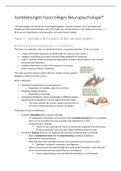College aantekeningen
College aantekeningen Neuropsychology (volledig)
- Instelling
- Radboud Universiteit Nijmegen (RU)
Dit document met extreem veel pagina's (134 welgeteld) is de ultieme voorbereiding voor het tentamen van het vak Neuropsychology! Het zijn aantekeningen van de colleges, waarin alle afbeeldingen zijn verwerkt en alles puntsgewijs is uitgelegd. De colleges zijn in het Engels gegeven, dus de aanteke...
[Meer zien]







